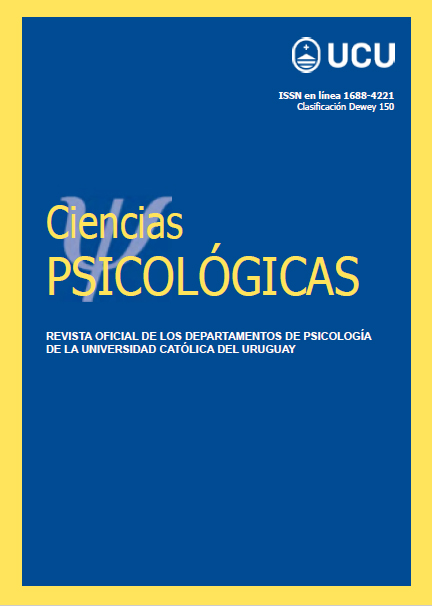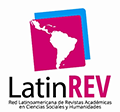Vulnerabilidad en las calles: un estudio sobre el uso de sustancias psicoactivas en personas en situación de calle
DOI:
https://doi.org/10.22235/cp.v19i2.4332Palabras clave:
población de calle, consumidores de drogas, trastornos relacionados con sustancias, estimulantes del sistema nervioso central, depresores del sistema nervioso centralResumen
Introducción: El consumo de sustancias psicoactivas en personas sin hogar prolonga la situación de calle y aumenta el riesgo de adquirir enfermedades crónicas e infecciosas. Objetivo: Identificar perfiles de consumo de sustancias en personas en situación de calle. Método: Estudio transversal con 368 personas en situación de calle que asistieron al Programa Centro Día en Itagüí, Antioquia, Colombia. La información relacionada con el consumo de sustancias psicoactivas se extrajo de las historias clínicas previo aval para su uso. Se conformaron perfiles de consumo de sustancias psicoactivas estimulantes, depresoras e hipnóticas del sistema nervioso central. Se estimaron prevalencia, razones de prevalencia y un análisis de correspondencias múltiple. Resultados: Participaron 88.3 % varones, con una edad media de 41.1 años (DE = 14.8). Se identificó una prevalencia de consumo de sustancias del 73.9 %, con mayor frecuencia de hipnóticos (marihuana) y depresores (alcohol). El análisis de los perfiles mostró que los hombres solteros con más de 3 meses en la calle eran más propensos a consumir drogas estimulantes y depresoras. Conclusiones: La persistencia en el consumo de sustancias psicoactivas, así como la falta de un manejo adecuado de las adicciones, incrementa la vulnerabilidad social, lo que puede agravar problemas como la mendicidad y la delincuencia.
Descargas
Citas
Acuto, M. (2019). We need a science of the night. Nature, 576(7787), 339. https://doi.org/10.1038/d41586-019-03836-2
Alfonso, O., Barrera, R. A., Bernal, P. I., Camargo, D. C., & Garzón, L. C. (2019). El ciclo mortal de los habitantes de la calle en Bogotá. Teorías, olvidos, políticas y desenlaces fatales. Revista de Economía Institucional, 21(41), 99-131. https://doi.org/https://doi.org/10.18601/01245996.v21n41.05
Almaguer, B., & González, A. (2014). Problemas relacionados con el alcohol en personas con conducta deambulante de la Habana. Medisur, 12(2), 451-455. http://scielo.sld.cu/scielo.php?script=sci_arttext&pid=S1727-897X2014000200014
Arias, A., & Pamplona, J. (2015). Razones de hombres jovenes habitantes de calle, entre los 20 y 50 años, para continuar viviendo en la calle [Degree dissertation]. Universidad de Antioquia. https://bibliotecadigital.udea.edu.co/bitstream/10495/14483/1/AriasAna_2015_RazonesHombresJovenes.pdf
Armoon, B., Griffiths, M. D., & Mohammadi, R. (2023). The Global Distribution and Epidemiology of Psychoactive Substance Use and Injection Drug Use Among Street-Involved Children and Youth: A Meta-Analysis. Substance Use & Misuse, 58(6), 746-764. https://doi.org/10.1080/10826084.2023.2181036
Asociación Médica Mundial. (2019). Declaración de Helsinki de la AMM-Principios éticos para las investigaciones médicas en seres humanos. 64ª Asamblea General. Fortaleza, Brasil.
Ato, M., López, J., & Benavente, A. (2013). Un sistema de clasificación de los diseños de investigación en psicología. Anales de Psicología, 29(3), 1038-1059. https://doi.org/https://doi.org/10.6018/analesps.29.3.178511
Baron, Y. (2018). Condiciones de vida y salud de habitantes de calle en Bogotá D.C, año 2017 [Master's dissertation]. Universidad Santo Tomás. https://repository.usta.edu.co/bitstream/handle/11634/15274/2019yurybaron.pdf?sequence=8&isAllowed=y
Baxter, A. J., Tweed, E. J., Katikireddi, S. V., & Thomson, H. (2019). Effects of Housing First approaches on health and well-being of adults who are homeless or at risk of homelessness: systematic review and meta-analysis of randomised controlled trials. Journal of Epidemiology and Community Health, 73(5), 379-387. https://doi.org/10.1136/jech-2018-210981
Bedoya-Mejia, S., Ramos-Jaraba, S., & Berbesí-Fernández, D. (2023). Factores asociados a la discriminación en personas que se inyectan drogas de dos ciudades de Colombia. Health and Additions, 23(2), 10-25. https://doi.org/https://doi.org/10.21134/haaj.v23i2.865
Berbesi-Fernandez, D., Agudelo, L., Castaño, C., Galeano, P., Segura-Cardona, A., & Montoya-Velez, L. (2014). Utilización de los servicios de salud en la población habitante de calle. CES Salud Pública, 5(2), 147-153. https://doi.org/https://revistas.ces.edu.co/index.php/ces_salud_publica/article/view/3076
Betancourt, C. A., Goldberg, D. G., Hawks, B. A., & Kitsantas, P. (2023). Perspectives of homeless veterans living with substance use disorders (SUD) and mental illness. Heliyon, 9(10), e20364. https://doi.org/10.1016/j.heliyon.2023.e20364
Borysow, I. D., Conill, E. M., & Furtado, J. P. (2017). Atencao a saude de pessoas em situacao de rua: estudo comparado de unidades moveis em Portugal, Estados Unidos e Brasil. Ciência & Saúde Coletiva, 22(3), 879-890. https://doi.org/10.1590/1413-81232017223.25822016
Brasesco, M. (2011). Niños de la Calle: Buenos Aires SXXI. Ciencias Psicológicas, 1, 7-18.
Bronfenbrenner, U., & Evans, G. (2000). Developmental science in the 21st century: Emerging questions, throretical, models, research designs and empirical findings. Social Development, 9(1), 115-125.
Brown, L., Rishel, H., & Page, K. A. (2025). Voices of the unhoused from Santa Fe, New Mexico: A mixed methods study of health status, substance use, and community harm reduction program perspectives. Journal of Prevention & Intervention in the Community, 52(1), 73-97. https://doi.org/10.1080/10852352.2024.2352266
Calderón, G., Gómez, M., Zapata, J., & Dávila, L. (2018). Factores de logro en procesos de resocialización del habitante en situación de calle y consumidor de sustancias psicoactivas en Medellín, Colombia. Health and Additions, 18(2), 143-154. https://doi.org/https://bibliotecadigital.udea.edu.co/bitstream/10495/28813/1/GomezMaricelly_2018_FactoresProcesosResocializacion.pdf
Cardoso-Ortiz, J., López-Luna, K., Cuevas-Flores, M., Florez de la Torre, J., & Covarrubias, S. (2020). Farmacología y epidemiología de Opiodes. Biocencias, 7, 955. https://doi.org/https://doi.org/10.15741/revbio.07.e955
CiudadSur. (2018). En Itagüí se abrió un Centro Día para habitantes de calle. https://ciudadsur.co/en-itagui-se-abrio-un-centro-dia-para-habitantes-de-calle/
Coleman, H. L. S., Levy-Philipp, L., Balt, E., Zuiderent-Jerak, T., Mander, H., Bunders, J., & Syurina, E. (2022). Addressing health needs of the homeless in Delhi: Standardising on the issues of Street Medicine practice. Global Public Health, 17(11), 2991-3004. https://doi.org/10.1080/17441692.2021.2023605
Congreso de Colombia. (2013). Ley 1641 de 2013: Por la cual se establecen los lineamientos para la formulación de la política pública social para habitantes de la calle y se dictan otras disposiciones.
Correa-Arango, M., & Zapata-Posada, J. (2007). La otra ciudad: los habitantes de la calle. Prospectiva. Revista de trabajo social e intervención social, 12, 181-204. https://doi.org/https://doi.org/10.25100/prts.v0i12.960
Costardi, J. V., Nampo, R. A., Silva, G. L., Ribeiro, M. A., Stella, H. J., Stella, M. B., & Malheiros, S. V. (2015). A review on alcohol: from the central action mechanism to chemical dependency. Revista da Associação Médica Brasileira, 61(4), 381-387. https://doi.org/10.1590/1806-9282.61.04.381
Departamento Administrativo Nacional de Estadística. (2021). Censo Habitantes de la Calle: información 2021.
Doran, K. M., Rahai, N., McCormack, R. P., Milian, J., Shelley, D., Rotrosen, J., & Gelberg, L. (2018). Substance use and homelessness among emergency department patients. Drug and Alcohol Dependence, 188, 328-333. https://doi.org/10.1016/j.drugalcdep.2018.04.021
Embleton, L., Mwangi, A., Vreeman, R., Ayuku, D., & Braitstein, P. (2013). The epidemiology of substance use among street children in resource-constrained settings: a systematic review and meta-analysis. Addiction, 108(10), 1722-1733. https://doi.org/10.1111/add.12252
Farigua, S., Pedraza, J., & Ruiz, R. (2018). Experiencias de habitantes de calle que asisten al programa de salud Camad Rafael Uribe en Bogotá. Revista Ciencias de la Salud, 16(3), 429-446. https://doi.org/https://doi.org/10.12804/revistas.urosario.edu.co/revsalud/a.7263
Fuster, D., & Gelberg, L. (2019). Community Screening, Identification, and Referral to Primary Care, for Hepatitis C, B, and HIV Among Homeless Persons in Los Angeles. J Community Health, 44(6), 1044-1054. https://doi.org/10.1007/s10900-019-00679-w
Gaber, S. N., Franck, J., Widing, H., Hallgren, J., Mattsson, E., & Westman, J. (2024). Excess mortality among people in homelessness with substance use disorders: a Swedish cohort study. J Epidemiol Community Health, 78(8), 473-478. https://doi.org/10.1136/jech-2023-220989
Gleason-Comstock, J., Bolden, C., Locke, B., Lakshmi, N., Cobty, K., Mckenney, T., Uddin, K., Bauer, S., & Xu, J. (2024). People who use drugs engagement in substance use disorder services and harm reduction: evaluation, challenges and future direction of a community-based intervention. Substance Abuse Treatment, Prevention, and Policy, 19(1), 24. https://doi.org/10.1186/s13011-024-00601-1
Gómez, A., Zuleta, H., & Zuleta, P. (2017). Habitante de calle, seguridad y adicción: Opciones jurídicas con sustento médico. In Documentos CEDE. Edición especial No. 53. Universidad de los Andes.
Hall, N., Le, L., Abimanyi-Ochom, J., Marel, C., Mills, K., Teesson, M., & Mihalopoulos, C. (2024). Estimating the societal cost of heroin dependence in an Australian population engaged in treatment or harm reduction services. Drug and Alcohol Dependence, 264, 112447. https://doi.org/10.1016/j.drugalcdep.2024.112447
Halpern, S. C., Scherer, J. N., Roglio, V., Faller, S., Sordi, A., Ornell, F., Dalbosco, C., Pechansky, F., Kessler, F., & Diemen, L. V. (2017). Vulnerabilidades clinicas e sociais em usuarios de crack de acordo com a situacao de moradia: um estudo multicentrico de seis capitais brasileiras. Cadernos de Saúde Pública, 33(6), e00037517. https://doi.org/10.1590/0102-311X00037517
Hammersley, R. (1996). Drug use and other problems of residents in projects for the young, single homeless. Health and Social Care, 4(4), 193-199. https://doi.org/https://doi.org/10.1111/j.1365-2524.1996.tb00064.x
Hernández-Carrillo, M., Álvarez-Claros, K., & Osorio-Sabogal, I. (2015). Consumo autoreportado de sustancias psicoactivas ilegales en una población habitante de calle de Cali-Colombia. Revista de Salud Pública, 17(2), 217-228. https://doi.org/https://doi.org/10.15446/rsap.v17n2.30016
Kemp, P. A., Neale, J., & Robertson, M. (2006). Homelessness among problem drug users: prevalence, risk factors and trigger events. Health & Social Care in the Community, (14), 319-328. https://doi.org/10.1111/j.1365-2524.2006.00624.x
Ministerio de Salud. (1993). Resolución 8430 de 1993, "Por la cuál se establecen las normas científicas, técnicas y administrativas para la investigación en salud".
Morin, K., Aubin, N., Molke, D., Marsh, D., Jean, N., Carter, J., & Leary, T. (2025). Perspectives on a transitional housing program for people who use substances who experience homelessness and live with a mental health issue: a pilot study in an urban northern city in Canada. Substance Abuse Treatment, Prevention, and Policy, 20(1), 20. https://doi.org/10.1186/s13011-025-00649-7
Motta-Ochoa, R., Incio-Serra, N., Brulotte, A., & Flores-Aranda, J. (2023). Motives for alcohol use, risky drinking patterns and harm reduction practices among people who experience homelessness and alcohol dependence in Montreal. Harm Reduction Journal, 20(1), 22. https://doi.org/10.1186/s12954-023-00757-2
Pares-Bayerri, A., Calvo, F., Font-Mayolas, S., Panadero, S., & Vazquez, J. J. (2023). Differences in Drug Use among Persons Experiencing Homelessness According to Gender and Nationality. International Journal of Environmental Research and Public Health, 20(5), 407. https://doi.org/10.3390/ijerph20054007
Paudyal, V., Vohra, N., Price, M., Jalal, Z., & Saunders, K. (2023). Key causes and long-term trends related to emergency department and inpatient hospital admissions of homeless persons in England. International Journal of Emergency Medicine, 16(1), 48. https://doi.org/10.1186/s12245-023-00526-9
República de Colombia & Ministerio de Salud y Protección Social. (2022). Decreto 1285 de 2022: Por medio del cual se adiciona el Capítulo 8 al Título 2 de la Parte 9 del Libro 2 del Decreto 780 de 2016 relativo a la Política Pública Social para Habitantes de la Calle 2022 -2031.
Rivera-Olmos, V. M., & Parra-Bernal, M. C. (2016). Cannabis: efectos en el sistema nervioso central. Consecuencias terapeuticas, sociales y legales. Revista medica del Instituto Mexicano del Seguro Social, 54(5), 626-634. https://www.ncbi.nlm.nih.gov/pubmed/27428345
Schlarb, A. A., Blunden, S., Brand, S., Bruni, O., Corkum, P., Horne, R. S. C., Ipsiroglu, O. S., Quante, M., Spruyt, K., & Owens, J. (2025). The future of paediatric sleep medicine: a blueprint for advancing the field. Journal of Sleep Research, e14482. https://doi.org/10.1111/jsr.14482
Song, A., Wenzel, S. L., & Cho, Y. (2021). Child Abuse Victimization, Depression, and Substance Use Among Homeless Women: Application of General Strain Theory. Journal of Interpersonal Violence, 36(17-18), 8852-8873. https://doi.org/10.1177/0886260519853410
Usdan, S. L., Schumacher, J. E., Milby, J. B., Wallace, D., McNamara, C., & Michael, M. (2001). Crack cocaine, alcohol, and other drug use patterns among homeless persons with other mental disorders. he American Journal of Drug and Alcohol Abuse, 27(1), 107-120. https://doi.org/10.1081/ada-100103121
Vazquez, J. J., & Berrios, A. (2022). Unhappiness and casual attributions of homelessness among people living homeless in Leon (Nicaragua). Journal of Community Psychology, 50(1), 592-600. https://doi.org/10.1002/jcop.22636
Vazquez, J. J., Berrios, A. E., & Suarez, A. C. (2020). Health, disability, and consumption of psychoactive substances among people in a homeless situation in Leon (Nicaragua). Social Work in Health Care, 59(9-10), 694-708. https://doi.org/10.1080/00981389.2020.1835785
Vegas, M., Mateos-Agut, M., Fuente-Anuncibay, R., Pineda-Otaola, P., & Sebastián-Vega, C. (2024). Relación entre consumo de sustancias y agresividad, problemas académicos, familiares y conductuales en adolescentes españoles. Health and Additions, 12, 1-20. https://doi.org/https://doi.org/10.21134/778
Descargas
Publicado
Cómo citar
Número
Sección
Licencia
Derechos de autor 2025 Ciencias Psicológicas

Esta obra está bajo una licencia internacional Creative Commons Atribución 4.0.
















